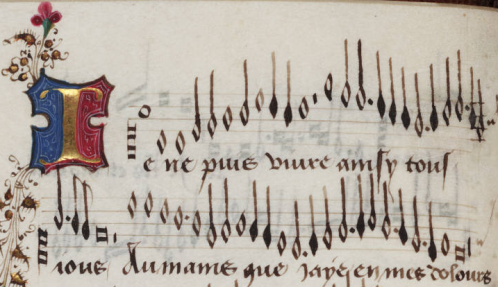In my previous blog post I spoke about the Renaissance in comparison to art and music. This week I would like to talk more about the music of the time, focusing specifically on Antoine Busnoys’s Je ne puis vivre, written in 1460.
Native to the Netherlands, Busnoys (1430-1492) attended the early Renaissance Burgundian School for composers located in what is now northern and eastern France, Belgium, and the Netherlands. The Burgundian school was the central musical practice of the Renaissance in Europe mostly due to its stability. Busnoys composed motets and sacred works, but he was most successful in French secular music, I have chosen to blog about the chanson (song) Je ne puis vivre.
Note: There are three French poetic forms, the ballade, rondeau and virelai. In fact Guilliame Machaut who I focused my last blog on; wrote a comprehensive repertory of these forms which continued to be used until the end of the fifteenth century. Out of the three forms, Machaut wrote 33 separate compositions in virelai.
 Back to Busnoys, Je ne puis vivre is written in AbbaA form. The chanson is split into 3 voices cantos, tenor, and countertenor with which voices alternate and repeat each other throughout the work. Between the A and B sections there are contrasting points in character, due to the abrupt change from
Back to Busnoys, Je ne puis vivre is written in AbbaA form. The chanson is split into 3 voices cantos, tenor, and countertenor with which voices alternate and repeat each other throughout the work. Between the A and B sections there are contrasting points in character, due to the abrupt change from
triple to duple-time.
Following the French themes of love and longing, Busnoys composed Je ne puis vivre after Jacqueline de Hacqueville who’s identity is uncertain, but by many sources presumed mistress of King Charles VII, wife of a Parliament member or a lady-in-waiting to the Queen of France. Busnois wrote at least three other songs containing her name, including the song “Ha que ville et habominable”, “How vile and abominable”. In Je ne puis vivre Busnoys uses her name as an acrostic poem. …….
Despite the complexity of his rhythms and melodies, Busnoys’s work sounds familiar and accessible to the modern ear. This song was the most familiar thing we have heard during this MUSA231 course, which comes down to the use of cadences. The fact that it is relatable to us really confirms the effects the Renaissance had in history. This rejuvenation and development through the exploration the arts in general is something we can relate the music too. It was a very exciting time.

Following on from this point I believe Busnoys set the mark for composers his notated music and vocal technique as well as his outlook on music was very influential. I believe you should all take a chance to listen to this beautiful piece of music, its use of form, call and response, angelic voices and the subject of the piece alone is enough to make you want to listen. But if you also enjoy the Renaissance period as a whole with the likes of Raphael and Michelangelo, it would be a good idea to put the music in context as it will help you to gain a better overview of the period.
